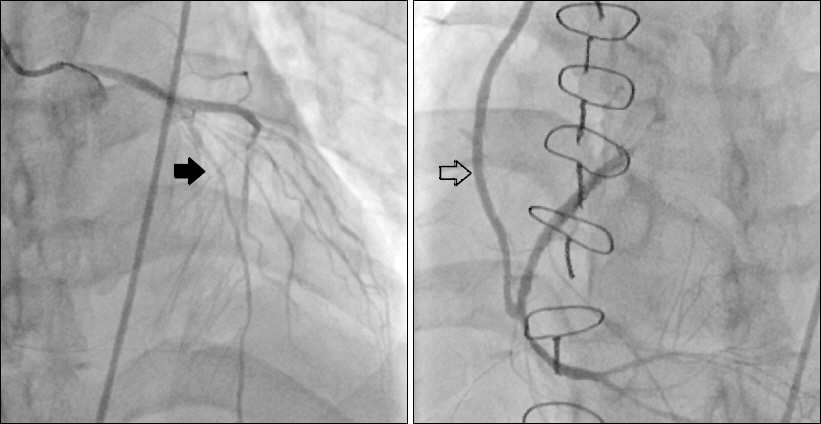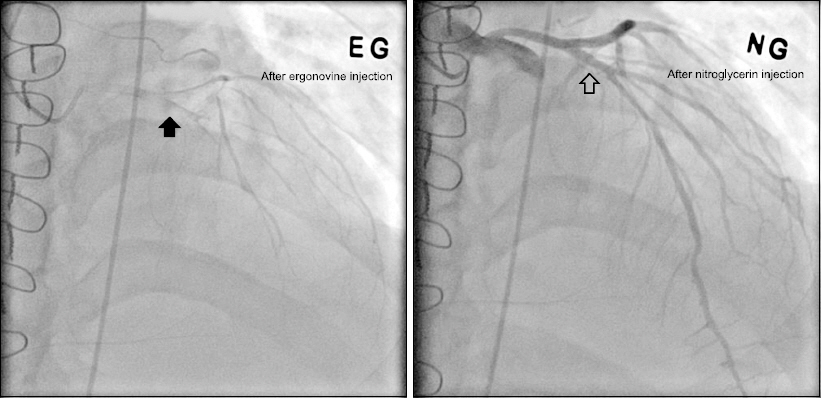Anesth Pain Med.
2017 Apr;12(2):155-158. 10.17085/apm.2017.12.2.155.
Resuscitated cardiac arrest caused by coronary artery spasm after coronary artery bypass grafting: A case report-
- Affiliations
-
- 1Department of Anesthesiology and Pain Medicine, Samsung Medical Center, Sungkyunkwan University School of Medicine, Seoul, Korea. sangminm.lee@samsung.com
- KMID: 2379737
- DOI: http://doi.org/10.17085/apm.2017.12.2.155
Abstract
- We report successful resuscitation of a patient after cardiac arrest on postoperative day 4 after coronary artery bypass grafting (CABG). The patient underwent proximal right coronary artery stent insertion 1 year preceding his CABG, and in-stent restenosis of the stent was found on coronary angiography (CAG). CABG was planned. The patient was treated with a nitroglycerin (NTG) for chest pain, and in the holding area of the operating theater, his chest pain resumed during brief cessation of the NTG while changing the syringe pump. Intraoperatively, normal flow was confirmed at the graft site with flowmetry, while the patient received a NTG infusion. On postoperative day 4, the patient developed chest pain and a subsequent cardiac arrest. He was resuscitated with chest compressions alone, and emergent CAG was performed. It showed coronary artery spasm of the left anterior descending coronary artery, confirmed by provocation testing. The patient was discharged with symptoms well controlled on oral medications.
Keyword
MeSH Terms
Figure
Reference
-
1. Keogh B, Kinsman R. Fifth national adult cardiac surgical database report 2003:Improving outcomes for patients. oxfordshire UK: Dendrite Clinical Systems;2004. Available from http://discovery.ucl.ac.uk/id/eprint/36440.2. Fabricius AM, Gerber W, Hanke M, Garbade J, Autschbach R, Mohr FW. Early angiographic control of perioperative ischemia after coronary artery bypass grafting. Eur J Cardiothorac Surg. 2001; 19:853–8. DOI: 10.1016/S1010-7940(01)00692-3.3. Maseri A, L’Abbate A, Baroldi G, Chierchia S, Marzilli M, Ballestra AM, et al. Coronary vasospasm as a possible cause of myocardial infarction. A conclusion derived from the study of “preinfarction” angina. N Engl J Med. 1978; 299:1271–7. DOI: 10.1056/NEJM197812072992303. PMID: 714095.4. Yasue H, Kugiyama K. Coronary spasm:clinical features and pathogenesis. Intern Med. 1997; 36:760–5. DOI: 10.2169/internalmedicine.36.760. PMID: 9392345.5. Nakamura M, Takeshita A, Nose Y. Clinical characteristics associated with myocardial infarction, arrhythmias, and sudden death in patients with vasospastic angina. Circulation. 1987; 75:1110–6. DOI: 10.1161/01.CIR.75.6.1110. PMID: 3568322.6. Lorusso R, Crudeli E, Lucà F, De Cicco G, Vizzardi E, D’Aloia A, et al. Refractory spasm of coronary arteries and grafted conduits after isolated coronary artery bypass surgery. Ann Thorac Surg. 2012; 93:545–51. DOI: 10.1016/j.athoracsur.2011.09.078. PMID: 22206957.7. Paterson HS, Jones MW, Baird DK, Hughes CF. Lethal postoperative coronary artery spasm. Ann Thorac Surg. 1998; 65:1571–3. DOI: 10.1016/S0003-4975(98)00098-8.8. Buxton AE, Goldberg S, Harken A, Hirshfield J Jr, Kastor JA. Coronary-artery spasm immediately after myocardial revascularization:recognition and management. N Engl J Med. 1981; 304:1249–53. DOI: 10.1056/NEJM198105213042101. PMID: 6783907.9. Kim YL, Kim EJ, Seo DM, Lee JH, Lee SG, Ban JS. Coronary artery spasm following intravenous phenylephrine on a patient under general anesthesia with previously undiagnosed variant angina and successful treatment by nitroglycerin:A case report. Anesth Pain Med. 2013; 8:99–103.10. Brott BC, Anayiotos AS, Chapman GD, Anderson PG, Hillegass WB. Severe, diffuse coronary artery spasm after drug-eluting stent placement. J Invasive Cardiol. 2006; 18:584–92. PMID: 17197707.11. Virmani R, Liistro F, Stankovic G, Di Mario C, Montorfano M, Farb A, et al. Mechanism of late in-stent restenosis after implantation of a paclitaxel derivate-eluting polymer stent system in humans. Circulation. 2002; 106:2649–51. DOI: 10.1161/01.CIR.0000041632.02514.14. PMID: 12438288.12. Zaya M, Mehta PK, Merz CN. Provocative testing for coronary reactivity and spasm. J Am Coll Cardiol. 2014; 63:103–9. DOI: 10.1016/j.jacc.2013.10.038. PMID: 24201078. PMCID: PMC3914306.
- Full Text Links
- Actions
-
Cited
- CITED
-
- Close
- Share
- Similar articles
-
- Native Coronary Artery and Grafted Artery Spasm Just after Coronary Artery Bypass Grafting: A Case Report
- Intractable Coronary Spasm Requiring Percutaneous Coronary Intervention after Coronary Artery Bypass Grafting in a Patient with Moyamoya Disease
- Low Cardiac Output Syndrome Caused by a Coronary Artery Spasm following CABG
- Aspiration Thromboembolectomy in the Management of Acute Coronary Occlusion during Pertaneous Transluminal Coronary Angioplasty
- Refractory Coronary Artery Spasm after Minimally Invasive Direct Coronary Artery Bypass Grafting




